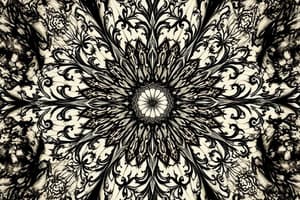Podcast
Questions and Answers
What type of projective test involves individuals adding comprehensive meaning to unstructured stimuli?
What type of projective test involves individuals adding comprehensive meaning to unstructured stimuli?
- Interpretive test (correct)
- Constructive test
- Constitutive test
- Refractive test
What type of projective test involves individuals expressing their personalities through art, handwriting, etc.?
What type of projective test involves individuals expressing their personalities through art, handwriting, etc.?
- Constructive test
- Constitive test
- Refractive test (correct)
- Interpretive test
According to Frank (1939), which type of projective test requires examinees to impose a degree of structure upon the situation?
According to Frank (1939), which type of projective test requires examinees to impose a degree of structure upon the situation?
- Interpretive test
- Constructive test (correct)
- Refractive test
- Constitutive test
Which type of projective test involves examinees framing structures upon unstructured materials?
Which type of projective test involves examinees framing structures upon unstructured materials?
What is the primary difference between constitutive and constructive projective tests?
What is the primary difference between constitutive and constructive projective tests?
Which type of projective test is NOT mentioned in the classification by Frank (1939)?
Which type of projective test is NOT mentioned in the classification by Frank (1939)?
What is the primary goal of projective tests?
What is the primary goal of projective tests?
What characteristic of projective tests allows participants to abandon their guarded persona?
What characteristic of projective tests allows participants to abandon their guarded persona?
What is a key assumption underlying projective personality assessment methods?
What is a key assumption underlying projective personality assessment methods?
What type of features do projective tests aim to reveal?
What type of features do projective tests aim to reveal?
What is NOT a characteristic of projective tests?
What is NOT a characteristic of projective tests?
What is the role of the translator in projective tests?
What is the role of the translator in projective tests?
What is the underlying assumption of projective tests regarding the subjects' responses?
What is the underlying assumption of projective tests regarding the subjects' responses?
What is the primary characteristic of unstructured stimuli in projective tests?
What is the primary characteristic of unstructured stimuli in projective tests?
What is the fundamental working behind projective tests?
What is the fundamental working behind projective tests?
What is the term introduced by Frank (1948) to describe a category of tests for studying personality?
What is the term introduced by Frank (1948) to describe a category of tests for studying personality?
What is the primary advantage of using unstructured stimuli in projective tests?
What is the primary advantage of using unstructured stimuli in projective tests?
What is the category of projective tests that focuses on the underlying motivations and unconscious feelings of individuals?
What is the category of projective tests that focuses on the underlying motivations and unconscious feelings of individuals?
Flashcards are hidden until you start studying
Study Notes
Projective Tests
- Projective tests are based on the idea that individuals project their personality attributes (latent and unconscious) onto unstructured stimuli during interpretation.
Types of Projective Tests
- Constitutive tests: examinees constitute or frame structures upon unstructured materials (e.g., Rorschach's Inkblot)
- Constructive tests: individuals impose a degree of structure upon the situation based on examiner's directions (e.g., Draw-A-Person Test)
- Interpretive tests: examinees add comprehensive meaning to stimuli (e.g., Thematic Apperception Test)
- Refractive tests: examinees express their personalities through painting, drawing, handwriting, etc.
Characteristics of Projective Tests
- Stimulus material is generally vague, relatively undefined, and unbiased
- Assessments employ an unqualified translator who may give their imaginations and partialities into rendering the participant's creation
- Evaluations utilize insensible or implied personality features revealed in the tests
- Methods use the subject's psychological instead of actual, real, important in their attitudes, beliefs, conflicts, fantasies, and ideas
Fundamental Assumptions
- Projective personality assessment methods are closely related to psychoanalytic theory and model
- Methods include stimuli demonstration, without cultural meaning and edifice, and consists of pictures, inkblots, partial stories or spoken sentences, or presentation tasks
- Materials allow subjects to express holistic and distinctive aspects of their personalities
- Subjects are not aware of the purpose and meaning of their responses to the tests
Key Concepts
- Unstructured stimuli exposure is a basic aspect that inspires patients to freely present their ideas
- Projective tests are indirect measures of personality
- Individuals project their feelings, needs, motives, etc. onto ambiguous stimuli when responding
- These needs, feelings, emotions, etc., are mostly latent and unconscious
Studying That Suits You
Use AI to generate personalized quizzes and flashcards to suit your learning preferences.




